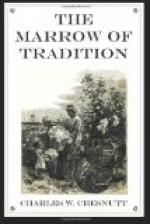As the day wore on, Ellis’s personal responsibility for the intended auto-da-fe bore more heavily upon him. Suppose he had been wrong? He had seen the accused negro; he had recognized him by his clothes, his whiskers, his spectacles, and his walk; but he had also seen another man, who resembled Sandy so closely that but for the difference in their clothes, he was forced to acknowledge, he could not have told them apart. Had he not seen the first man, he would have sworn with even greater confidence that the second was Sandy. There had been, he recalled, about one of the men—he had not been then nor was he now able to tell which—something vaguely familiar, and yet seemingly discordant to whichever of the two it was, or, as it seemed to him now, to any man of that race. His mind reverted to the place where he had last seen Sandy, and then a sudden wave of illumination swept over him, and filled him with a thrill of horror. The cakewalk,—the dancing,—the speech,—they were not Sandy’s at all, nor any negro’s! It was a white man who had stood in the light of the street lamp, so that the casual passer-by might see and recognize in him old Mr. Delamere’s servant. The scheme was a dastardly one, and worthy of a heart that was something worse than weak and vicious.
Ellis resolved that the negro should not, if he could prevent it, die for another’s crime; but what proof had he himself to offer in support of his theory? Then again, if he denounced Tom Delamere as the murderer, it would involve, in all probability, the destruction of his own hopes with regard to Clara. Of course she could not marry Delamere after the disclosure,—the disgraceful episode at the club would have been enough to make that reasonably certain; it had put a nail in Delamere’s coffin, but this crime had driven it in to the head and clinched it. On the other




